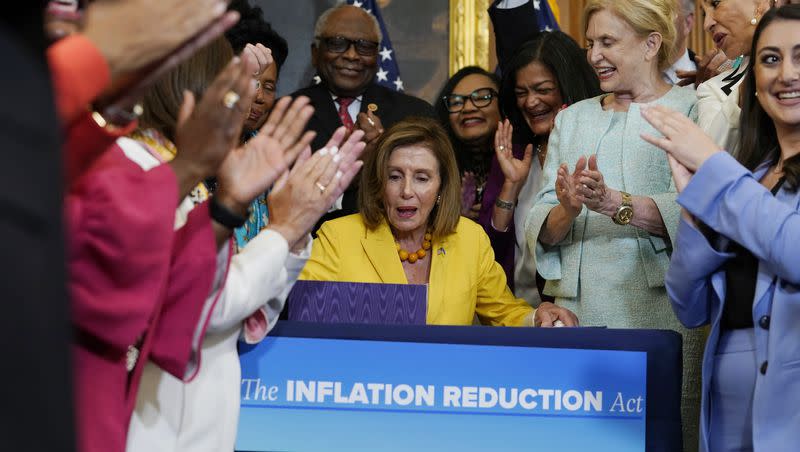One year later: What has the Inflation Reduction Act accomplished?

- Oops!Something went wrong.Please try again later.
During his visit to Utah on Thursday, President Joe Biden shared his thoughts on the Inflation Reduction Act, a year after it was signed into law.
“I wish I hadn’t called it that because it has less to do with reducing inflation than it has to do with providing alternatives that generate economic growth,” Biden said, according to Fortune.
The IRA was signed into law on Aug. 16, 2022. U.S. inflation rates have declined since last year, Deseret News reported, dropping from 9.1% last June to 3.2% in June of this year. Did the Inflation Reduction Act have anything to do with the drop?
What caused inflation rates to drop? Biden himself has claimed that the IRA “has nothing to do with inflation,” per The Associated Press, so why did the rates dip?
Economists say that inflation rates were influenced by three entirely external facts from the act: oil and gas prices, interest rates, and the supply chain.
According to The Associated Press, since last year, oil and gas prices have dropped from a high spike in June 2022, due to Russia’s invasion of Ukraine, and have fallen steadily until January. Although fuel prices are increasing again, as is usual for the summer, they still haven’t reached last year’s peak.
The Associated Press states that raising federal interest rates was another contributor to declining interest rates. This move “made it more expensive to borrow and slowed demand that had been pushing up prices.” Since the Federal Reserve raised interest rates, home prices have decreased since last year, along with rental and auto prices.
The nation is seeing the strain from the pandemic unfurl, as blocks in the supply chain have begun to smooth, resulting in lower prices overall, AP reported.
Related
U.S. inflation just jumped for the first time in a year. Should we be worried?
What does the Inflation Reduction Act mean for the average American?
This plan to cut drug prices could result in lost jobs and fewer medicines. Here’s why
Although inflation rates are still higher than the Fed’s 2% target, The Associated Press stated that the Biden administration takes responsibility in part for cooling inflation.
“By releasing oil from the U.S. strategic reserve, they say, they reduced the financial pain at the gas pump. The administration also created a task force to improve U.S. port activity and supply chains. The White House also stayed quiet on Fed rate hikes, giving the central bank the independence to work without political pressure,” The Associated Press said.
So, what did the IRA accomplish? If anything, the IRA was an act aimed at climate change rather than inflation. This is according to Biden himself, who stated, “It has nothing to do with inflation. ... It has to do with the $368 billion, the single largest investment in climate change anywhere in the world, anywhere. No one has ever, ever spent that. And it’s beginning to take hold,” via Fortune.
Nirupama Rao, assistant professor of business economics and public policy at the University of Michigan, called the IRA a “climate change bill, paired with a bunch of deficit reduction,” according to Fast Company. “This was a bit of well-paced marketing to call it the Inflation Reduction Act,” she said.
According to the Deseret News, a large chunk of the IRA offered incentives to companies and individuals for using clean energy technology. Time magazine said that the impact of this incentive was “quick and immediate,” as many companies began to invest more than $270 billion in clean energy products, beginning the very week the bill was passed.
Health care was another primary focus of the IRA, as it aimed to expand Medicare and lower prescription drug costs. The implementation of this section of the bill has manifested through reduced insulin prices, a yearly cap on out-of-pocket prescription costs through Medicare, and Medicare rebates, according to the Centers for Medicare and Medicaid Services.
What’s next? The Federal Reserve expects that inflation will stay the same through 2024, remaining above the 3.5% rate, which is about where it stands now.
The benefits of the IRA have been promised to Americans for at least the next decade. According to USA Today, through the act, the cap for out-of-pocket prescription drugs will go from $4,000 annually in 2024, to $2,000 in 2026. The bill’s tax breaks for clean energy investments are expected to reduce carbon emissions by 40% by 2030. The bill sets to expand IRS tax assistance over the next 10 years and to expand the Affordable Care Act’s federal subsidies to 2025.

